concrete
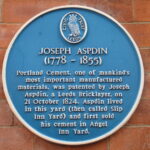 People in our modern-day world truly take some of history’s inventions for granted. Things that have been around for a long time, are especially susceptible. Around 3000 BC, the Egyptians used early concrete forms as mortar in their construction work. The Great Pyramids at Giza were built from an early form of concrete, and they are still standing today. It seems strange to think of concrete existing way back then, but it actually did. It might not have been in exactly the same form as the concrete of today. In fact, the Bible tells of using clay and straw to make bricks and mortar. It seems rather archaic to us these days, and but then it seems to have lasted a whole lot longer than some of the concrete of today, so maybe some of it was better.
People in our modern-day world truly take some of history’s inventions for granted. Things that have been around for a long time, are especially susceptible. Around 3000 BC, the Egyptians used early concrete forms as mortar in their construction work. The Great Pyramids at Giza were built from an early form of concrete, and they are still standing today. It seems strange to think of concrete existing way back then, but it actually did. It might not have been in exactly the same form as the concrete of today. In fact, the Bible tells of using clay and straw to make bricks and mortar. It seems rather archaic to us these days, and but then it seems to have lasted a whole lot longer than some of the concrete of today, so maybe some of it was better.
Portland cement was invented by Joseph Aspdin of England in 1824. The first concrete 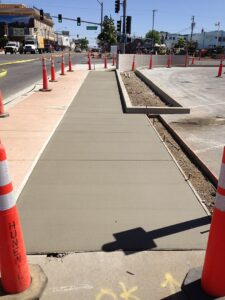 paved street in the United States was laid in Bellefontaine, Ohio in 1891. The street was paved by George W Bartholomew, who owned the Buckeye Portland Cement Company and convinced city officials to let him pave an eight-foot-wide strip of Main Street with a mixture of sand, stone, and cement. Two years later, city officials agreed to let Bartholomew pave an entire block of Court Avenue between Main Street and Opera Street, which today remains the oldest concrete street in America, and it still exists, unlike some of the products currently used for streets today.
paved street in the United States was laid in Bellefontaine, Ohio in 1891. The street was paved by George W Bartholomew, who owned the Buckeye Portland Cement Company and convinced city officials to let him pave an eight-foot-wide strip of Main Street with a mixture of sand, stone, and cement. Two years later, city officials agreed to let Bartholomew pave an entire block of Court Avenue between Main Street and Opera Street, which today remains the oldest concrete street in America, and it still exists, unlike some of the products currently used for streets today.
Steel-reinforced concrete was developed by the end of the 19th century. August Perret designed and built an apartment building in Paris using steel-reinforced concrete in 1902. The building was widely admired, and with that building came a new popularity for concrete. In fact, the building influenced further development of reinforced concrete. Eugène Freyssinet really pioneered reinforced-concrete construction by building two colossal parabolic-arched airship hangars at Orly Airport in Paris in 1921.
Concrete has undergone several changes since 1921. During the 21st century, concrete manufacturers have 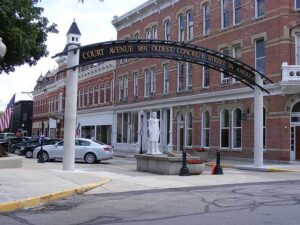 sstarted changing many of their product formulas in ways that increase early strength and lessen later age trength. This threw me a little bit, but the primary reason for this shift is said to be practical…”On a construction site, you can remove the forms from new concrete much faster if it has high early strength 1. Additionally, according to AZoBuild.com, concrete has gone through numerous changes over the last few decades despite its appearance looking almost the same. These changes include the development of environmentally friendly concrete products.” I’m not sure these changes are all that good, because they seem to cause more cracking and an earlier breakdown of the concrete. I’m not a contractor, but that doesn’t seem like a good thing to me.
sstarted changing many of their product formulas in ways that increase early strength and lessen later age trength. This threw me a little bit, but the primary reason for this shift is said to be practical…”On a construction site, you can remove the forms from new concrete much faster if it has high early strength 1. Additionally, according to AZoBuild.com, concrete has gone through numerous changes over the last few decades despite its appearance looking almost the same. These changes include the development of environmentally friendly concrete products.” I’m not sure these changes are all that good, because they seem to cause more cracking and an earlier breakdown of the concrete. I’m not a contractor, but that doesn’t seem like a good thing to me.
 The Hoover Dam was built completed in 1935 and was considered was the greatest concrete project ever recorded, using more masonry than the Great Pyramid at Giza (4.5 million cubic yards) and equal to the amount needed to build a two-lane highway from Seattle to Miami, or a 4-foot-wide sidewalk around the Equator. It is the highest dam in the Western Hemisphere. The dam stands 726 feet above the Colorado River. It measures 1,244 feet across at the top, 660 feet thick at the base, and 45 feet thick at the top. It weighs a whopping 6.6 million tons, or at least the sum of its parts weighs that.
The Hoover Dam was built completed in 1935 and was considered was the greatest concrete project ever recorded, using more masonry than the Great Pyramid at Giza (4.5 million cubic yards) and equal to the amount needed to build a two-lane highway from Seattle to Miami, or a 4-foot-wide sidewalk around the Equator. It is the highest dam in the Western Hemisphere. The dam stands 726 feet above the Colorado River. It measures 1,244 feet across at the top, 660 feet thick at the base, and 45 feet thick at the top. It weighs a whopping 6.6 million tons, or at least the sum of its parts weighs that.
The Mike O’Callaghan–Pat Tillman Memorial Bridge came along 75 years later. It is an arch bridge that spans the Colorado River between the states of Arizona and Nevada. Located in  the Lake Mead National Recreation Area approximately 30 miles southeast of Las Vegas, it was designed to reroute US 93 from its previous routing along the top of Hoover Dam and removed several hairpin turns and blind curves from the route. The new bridge, which opened in 2010, carries Interstate 11 and US Route 93 over the Colorado River. It was the most important part of the Hoover Dam Bypass project. It is jointly named for Mike O’Callaghan, Governor of Nevada from 1971 to 1979, and Pat Tillman, an American football player who left his career with the Arizona Cardinals to enlist in the United States Army and was killed in Afghanistan in 2004 by friendly fire.
the Lake Mead National Recreation Area approximately 30 miles southeast of Las Vegas, it was designed to reroute US 93 from its previous routing along the top of Hoover Dam and removed several hairpin turns and blind curves from the route. The new bridge, which opened in 2010, carries Interstate 11 and US Route 93 over the Colorado River. It was the most important part of the Hoover Dam Bypass project. It is jointly named for Mike O’Callaghan, Governor of Nevada from 1971 to 1979, and Pat Tillman, an American football player who left his career with the Arizona Cardinals to enlist in the United States Army and was killed in Afghanistan in 2004 by friendly fire.
While the original design of the Hoover Dam seemed like a great idea, it was shown to be dangerous as early as the 1960s. The dam was also inadequate for projected traffic volumes. Work 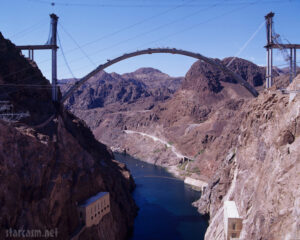 on a different design began in 1998, and in March of 2001, the Federal Highway Administration selected the route, which crosses the Colorado River approximately 1,500 feet downstream of Hoover Dam. The construction of the bridge approaches began in 2003, and construction of the bridge itself began in February 2005. The bridge was completed in 2010 and the entire bypass route on October 16, 2010…opening to vehicle traffic on October 19, 2010. The Hoover Dam Bypass project was completed within budget at a cost of $240 million; the bridge portion cost $114 million. The bridge was also strategically placed to help prevent a terrorist attack, because it kept visitors away from the dam itself.
on a different design began in 1998, and in March of 2001, the Federal Highway Administration selected the route, which crosses the Colorado River approximately 1,500 feet downstream of Hoover Dam. The construction of the bridge approaches began in 2003, and construction of the bridge itself began in February 2005. The bridge was completed in 2010 and the entire bypass route on October 16, 2010…opening to vehicle traffic on October 19, 2010. The Hoover Dam Bypass project was completed within budget at a cost of $240 million; the bridge portion cost $114 million. The bridge was also strategically placed to help prevent a terrorist attack, because it kept visitors away from the dam itself.

 I first met my nephew, Riley Birky, when he was 9 years old, and his mom, Rachel Schulenberg married my brother-in-law, Ron Schulenberg. Over the years that he has been in our family, Riley has gone through the fairly typical years of a kid, with the teen years being typically the most tumultuous, as is the case with most teens. While those were tough times for Riley, one thing that you could always count on, was that you could always count on Riley. Riley might not have always been excited about helping out, but if he said he would help you with something, he would. He always had a tendency to take care of everybody before himself. If there is a call for assistance with something, Riley will be the first to respond. His mom say of Riley, “He is so brave and committed and always striving to do his best.”
I first met my nephew, Riley Birky, when he was 9 years old, and his mom, Rachel Schulenberg married my brother-in-law, Ron Schulenberg. Over the years that he has been in our family, Riley has gone through the fairly typical years of a kid, with the teen years being typically the most tumultuous, as is the case with most teens. While those were tough times for Riley, one thing that you could always count on, was that you could always count on Riley. Riley might not have always been excited about helping out, but if he said he would help you with something, he would. He always had a tendency to take care of everybody before himself. If there is a call for assistance with something, Riley will be the first to respond. His mom say of Riley, “He is so brave and committed and always striving to do his best.”
Those kid days are long gone now, and Riley is grown up. He works very hard doing concrete work at Griffis Quality Fencing and Welding in Powell, Wyoming. Riley likes his job and is a great employee. He finds the work interesting. Riley has grown into a good man, and that is one of the best things that can be said about a man. Riley likes his job, but it isn’t all that he is about. Like most people, your job is what you do to earn money to do what you want to do. Riley likes adventure…doing something new and exciting. He also loves the outdoors.

 Riley has grown up so much in the past year. He has a great group of friends, who have been there for him. He has also been blessed with a wonderful girlfriend, Sierah Martin, and her two-year-old son, Jace. Riley loves kids, and was always such a great big brother to his brother, Tucker Schulenberg. They don’t get to see each other as much as they used to, since Tucker lives in Casper, but they are still close. Riley was also blessed this year to become a godparent to a sweet little boy. I think that has been a great honor to him. Today is Riley’s 20th birthday. Happy birthday Riley!! Have a great day!! We love you!!
Riley has grown up so much in the past year. He has a great group of friends, who have been there for him. He has also been blessed with a wonderful girlfriend, Sierah Martin, and her two-year-old son, Jace. Riley loves kids, and was always such a great big brother to his brother, Tucker Schulenberg. They don’t get to see each other as much as they used to, since Tucker lives in Casper, but they are still close. Riley was also blessed this year to become a godparent to a sweet little boy. I think that has been a great honor to him. Today is Riley’s 20th birthday. Happy birthday Riley!! Have a great day!! We love you!!
 From the end of World War II, until the mid 1990s, the world was in the middle of the Cold War. The Soviet Union had developed atomic weapons, and they were threatening to use them. Tensions were high, because they were flexing all the military muscle they could. A common part of the administration was make sure that the people of the United States were ready for the very real possibility of an attack. The Eisenhower administration formed the Federal Civil Defense Administration (FCDA), later called the Office of Civil Defense, to instruct the people on what to do in the event of a nuclear attack.
From the end of World War II, until the mid 1990s, the world was in the middle of the Cold War. The Soviet Union had developed atomic weapons, and they were threatening to use them. Tensions were high, because they were flexing all the military muscle they could. A common part of the administration was make sure that the people of the United States were ready for the very real possibility of an attack. The Eisenhower administration formed the Federal Civil Defense Administration (FCDA), later called the Office of Civil Defense, to instruct the people on what to do in the event of a nuclear attack.
On this day, October 6, 1961, President Kennedy urged the people of the United States to build bomb shelters, so they could live through the nuclear fallout in the event of an attack. I was a girl of just five years, in 1961, but I vividly remember seeing those fallout shelters and knowing that it was possible that the day could come when we might have to take shelter there. That is pretty scary stuff for a five year old girl, but it was simply the world we lived in.
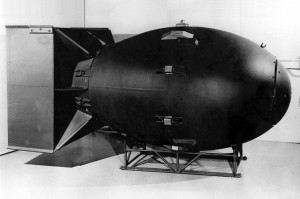 When I fast forward to this day and age, I have to wonder why some of the same precautions aren’t being put in place by this administration. We all know that Iran has nuclear weapons, and Russia, along with China, are beefing up their forces too. In many ways, the Cold War is in full force again, and no one seems to be reacting to the dangers. Maybe it is because we are getting used to the threat of nuclear war, but it still seems odd to me that there is not more preparation. Even I must admit that as a child, the fallout shelters were a source of unease for me, but now…even with the threat of nuclear war constantly in the news, I just don’t feel the same kind of concern…though maybe I should.
When I fast forward to this day and age, I have to wonder why some of the same precautions aren’t being put in place by this administration. We all know that Iran has nuclear weapons, and Russia, along with China, are beefing up their forces too. In many ways, the Cold War is in full force again, and no one seems to be reacting to the dangers. Maybe it is because we are getting used to the threat of nuclear war, but it still seems odd to me that there is not more preparation. Even I must admit that as a child, the fallout shelters were a source of unease for me, but now…even with the threat of nuclear war constantly in the news, I just don’t feel the same kind of concern…though maybe I should.
A fallout shelter was intended to reduce casualties in a nuclear war. It is designed to allow those inside it to avoid exposure to harmful fallout from a nuclear blast and its likely aftermath of radiation until radioactivity has dropped to a safer level. A basic fallout shelter consists of shielding that reduces gamma ray exposure. The most dangerous fallout has the consistency of sand or finely ground pumice, so a fallout shelter would not need to filter fine dust from air. The fine dust emits relatively little radiation. Concrete, bricks, earth, and sand are  some of the materials that are dense or heavy enough to provide fallout protection. Basically this shelter could be much like a tornado shelter, except that it would need to have a door that seals completely.
some of the materials that are dense or heavy enough to provide fallout protection. Basically this shelter could be much like a tornado shelter, except that it would need to have a door that seals completely.
Concrete was the most often used building material of fallout shelters, with walls at least 12 inches thick. The required shielding could be accomplished with 10 times the amount of any quantity of material capable of cutting gamma ray effects in half. Shields that reduce gamma ray intensity by 50 percent include 0.4 inches of lead, 2.4 inches of concrete, 3.6 inches of packed dirt or 500 feet of air. I suppose the main concern for most of us the difficulty building one of these shelters, Nevertheless, that is exactly what President Kennedy urged the people to do, and what many of them did do. It was terrifying stuff, and it makes you wonder what is wrong with people who would even consider detonating one of these nuclear bombs.

